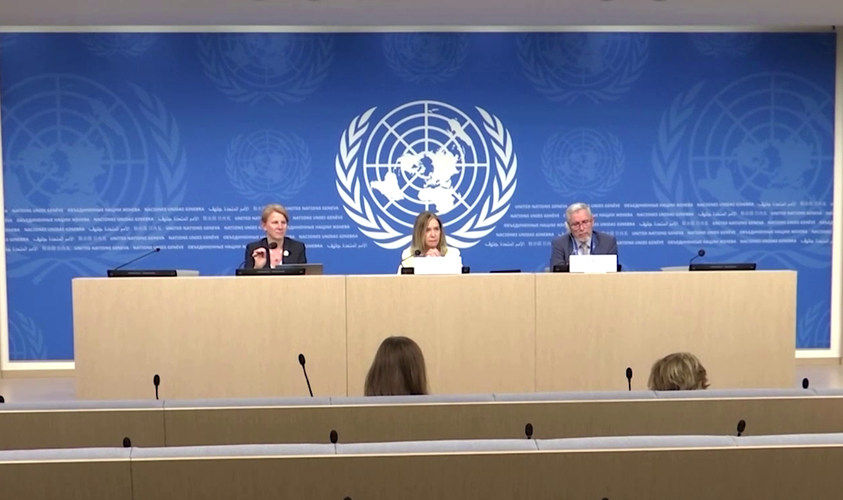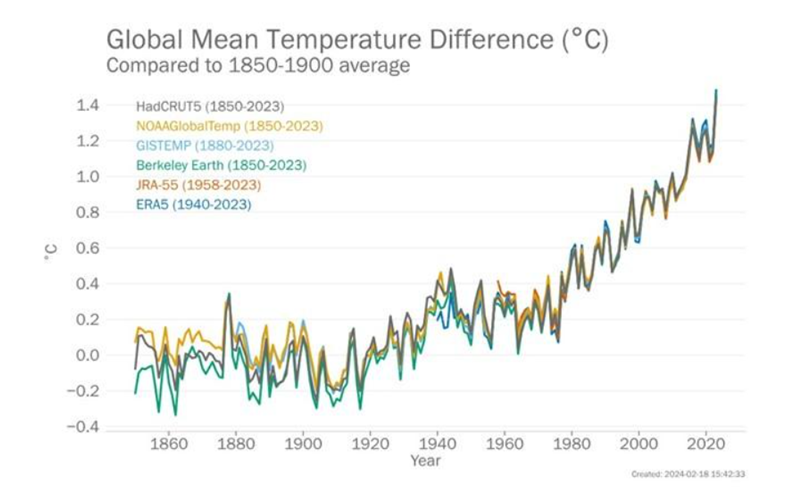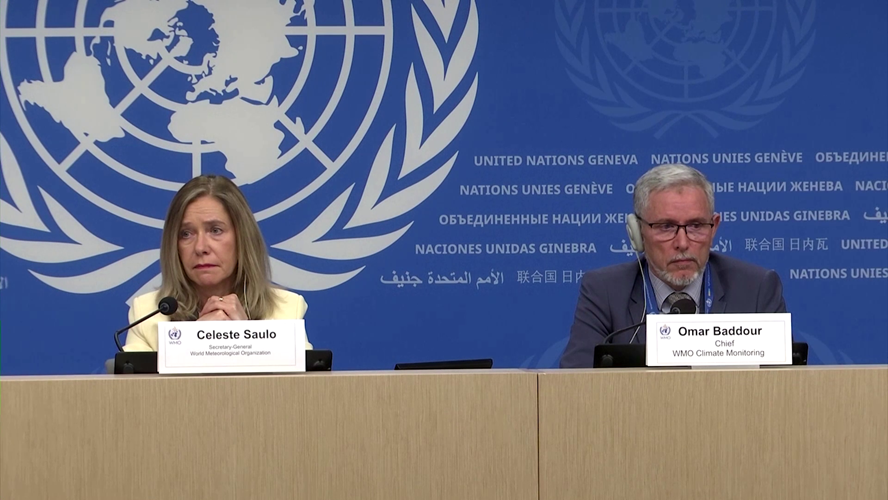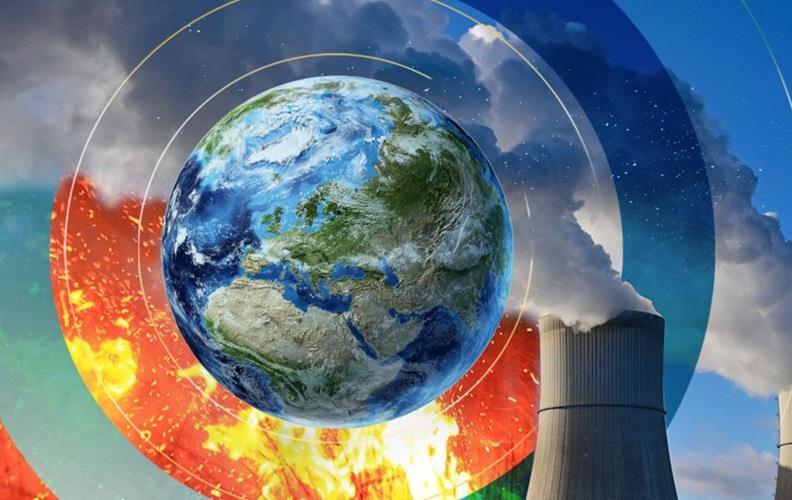
WMO: 2024 expected to exceed 2023's temperature records
21/03/2024TN&MTThe World Meteorological Organization (WMO) issued a "red alarm" on March 19, warning that every significant global climate record was shattered last year, raising concerns that 2024 could witness further deterioration. The chief of the international organization expressed particular unease regarding alarming trends of ocean heat increase and diminishing sea ice.
2023 witnessed a series of record-breaking climate indicators
The latest report from the World Meteorological Organization (WMO) unveiled a plethora of shattered records across various domains, including greenhouse gas levels, surface temperatures, ocean heat and acidification, sea level rise, Antarctic sea ice cover, and glacier retreat. The WMO's State of the Global Climate 2023 report highlighted extreme weather events globally, such as heatwaves, floods, droughts, wildfires, and intensifying tropical cyclones, which led to substantial economic losses and disrupted millions of lives.

The World Meteorological Organization (WMO) released latest report on Marth 19.
Confirmed as the warmest year on record, 2023 saw the global average near-surface temperature soaring to 1.45°C above the pre-industrial baseline, marking the warmest decade in history. United Nations Secretary-General António Guterres expressed alarm at the situation, emphasizing the acceleration of changes as records were not merely broken but surpassed, with unprecedented warmth surpassing previous records set by 2016 and 2020.
Monthly records were consistently shattered from June to December, with September 2023 notably standing out for its significant margin over the previous record. The rise in temperatures was attributed to increasing greenhouse gas levels, exacerbated by a shift from La Niña to El Niño conditions in mid-2023.
Global average sea-surface temperatures reached record highs, particularly from April onwards, with notable warming observed in various regions. Despite the presence of El Niño in the Tropical Pacific, anomalous warming occurred in some areas, such as the Northeast Atlantic.

Annual global mean temperature anomalies (relative to 1850–1900) from 1850 to 2023. Data are from six data sets
WMO Secretary-General Celeste Saulo underscored the urgency of the climate crisis, particularly highlighting 2023's unprecedented ocean warmth, glacier retreat, and Antarctic sea ice loss. Nearly one-third of the global ocean experienced marine heatwaves in 2023, posing threats to ecosystems and food systems. Furthermore, the year witnessed the largest ice loss on record for reference glaciers and the lowest Antarctic sea ice extent. Ms. Celeste Saulo stressed the intricate linkages between the climate crisis and other global challenges, including inequality, food insecurity, population displacement, and biodiversity loss.

WMO Secretary-General Celeste Saulo & Chief of WMO Climate monitoring Omar Baddour at press conference on March 19.
Driven by a combination of climate change from fossil fuel consumption and the natural El Niño climate phenomenon, 2023 propelled the world into record-breaking territory. Mr. Omar Baddour, head of climate monitoring at WMO, hinted at a "high probability" of 2024 surpassing previous heat records, noting the historical trend of even warmer temperatures following an El Niño event. The global population facing acute food insecurity has more than doubled, from 149 million before the COVID-19 pandemic to 333 million in 2023 (across 78 monitored countries by the World Food Programme). While weather and climate extremes are not the sole root cause, they exacerbate the situation, as indicated by the report.
Hope in renewable energy transition and climate action costs
Renewable energy generation, driven by solar radiation, wind, and the water cycle, has surged as a key strategy in climate action, aiming to achieve decarbonization targets. In 2023, renewable capacity additions jumped by nearly 50% from 2022, totaling 510 gigawatts (GW) – the highest rate observed in the past two decades.
This week, at the Copenhagen Climate Ministerial on 21-22 March, global climate leaders and ministers will convene for the first time since COP28 in Dubai to advocate for accelerated climate action. Enhancing countries' Nationally Determined Contributions (NDCs) ahead of the February 2025 deadline and forging an ambitious financing agreement at COP29 will be top priorities.

In 2023, renewable capacity additions jumped by nearly 50% from 2022 (Photo: Pixabay)
Ms. Celeste Saulo emphasized the importance of addressing the lack of capacity to deliver and utilize climate services for informing national mitigation and adaptation plans, especially in developing countries. Increased support for National Meteorological and Hydrological Services is essential to ensure that the next generation of NDCs is science-based.
In 2021/2022, global climate-related finance flows surged to nearly USD 1.3 trillion, almost doubling compared to 2019/2020 levels. Despite this increase, these tracked flows represent only around 1% of global GDP, as reported by the Climate Policy Initiative.
However, there remains a significant financing gap. In an average scenario aiming at a 1.5°C pathway, annual climate finance investments must grow by over six times, reaching almost USD 9 trillion by 2030 and an additional USD 10 trillion by 2050.
The projected cost of inaction is even more substantial, estimated at USD 1,266 trillion over the period 2025-2100. This represents the difference in losses between a business-as-usual scenario and those incurred within a 1.5°C pathway, although this figure is likely a conservative estimate.
Despite reaching an all-time high of USD 63 billion in 2021/2022, adaptation finance remains insufficient. The global adaptation financing gap continues to widen, falling well short of the estimated USD 212 billion per year needed up to 2030 in developing countries alone.
















